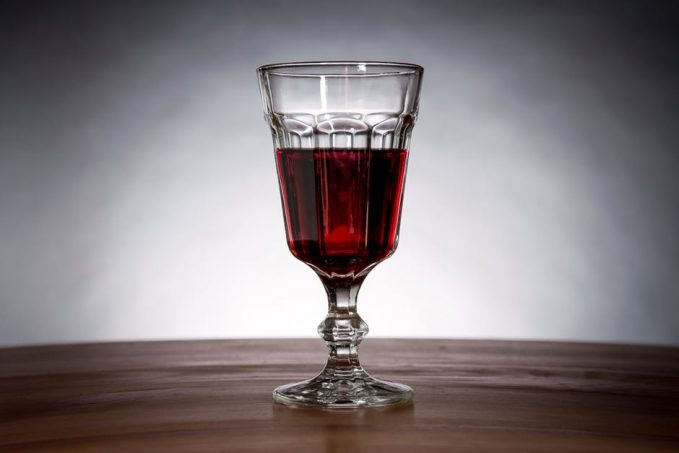
| It’s cheap. It’s one dimensional. It’s best when it’s real young. No, I’m not talking about your ideal date. I’m talkin’ ’bout one of my favorite wines in the entire world: nouveau Beaujolais! — red wines’ version of white zinfandel! Chateau Cashflow! From vine to bottle in about two months! I drink Beaujolais in mass quantities with alarming regularity. I’m often referred to as the Beaujolais poster girl. I got it bad for Beaujolais, nouveau in particular. But why, why, why you ask? Why be so excited about something so simple, fruity, tart?
First off, the process of making nouveau wines involves one of my favorite winemaking terms — “carbonic maceration.” No, it’s not that thing that Joycelyn Elders thought we should teach our teens in school. Carbonic maceration is fermentation taking place in an anaerobic environment; an intracellular fermentation taking place right within the skins of the grapes. It was actually Louis Pasteur who realized that different flavors and aromas resulted from grape berries being surrounded by carbon dioxide rather than by oxygen. Basically it’s a sterilized version of what happens when you leave grapes in your lunch box. By not crushing the skins prior to fermentation, as with most red wines, you lessen the degree of color, tannins and bitterness which, by macerating you’d normally impart in the wine. You follow? Okay, let’s go through the steps while I drink a glass of it to refresh my memory, shall we? First, the grape clusters (whole grapes and stems) are dropped through the top of a small stainless steel tank. The first clusters in hit bottom and break from the fall, splitting their skins and spilling some of their juice. After there’s about a foot or so of broken grapes and juice in the tank, the clusters tumbling in don’t break from the fall and thus remain unbroken. When the tank is full, it’s sparged with carbon dioxide then locked air tight. What happens in the tank is kinda like that Jell-O 1-2-3 stuff. (Do they still make that?) The juice at the bottom of the tank starts fermenting naturally with the “wild” yeast brought in on the skins from the vineyard. Or sometimes winemakers will add yeast to start the fermentation. Regardless, the whole clusters (swimming in their juices) begin to ferment slowly within their skins. The top layer of clusters, surrounded only by the carbon dioxide, undergo total carbonic maceration — fermentation in an anaerobic environment. Technically the wine doesn’t ferment to total dryness by this method alone. After about a week you have this yummy purple milk-like looking stuff that’s about nine percent alcohol and about three percent sugar. So at this point winemakers press the juice from the skins, put the “drain and press” juice into another tank and add a dose of yeast to finish the wine to dryness (no sugar). Then, after clarification, filtering, etc., the wine is bottled and allowed to sit for a bit prior to release. Voila! Without throwing y’all into narcoleptic shock (if I haven’t done so already), suffice it to say that this method of fermentation yields different flavors and esters (aromatic compounds) than more traditional fermentation methods. Hence, the jump-outta-the-glass/flag-waving-fruitiness of nouveau wines. Conception The first nouveau wines were produced in the 19th century, though the whole nouveau phenomenon didn’t really start until the 1920s. It’s only been in the last decade or so, however, that nouveau Beaujolais has really hit its stride. Its popularity continues to grow in this country as Americans abroad learn of “the red wine on training wheels” — Beaujolais. And, contrary to what you may hear some people say, if you like the way Nouveau tastes when it’s first released, it doesn’t go “bad” after Easter. That tart fruitiness just mellows into a smoother, lighter version of the “regular” Beaujolais. However, you have nothing to gain by holding on to it for a long time. Bedfellows Very few wines are as food-friendly as Beaujolais. It pairs well with just about any item on the buffet table or at the potluck BBQ and goes just as well with Jenny Craig, Lean Cuisine and Weight Watchers as it does with macaroni and cheese. If you haven’t tried nouveau Beaujolais with the typical American Thanksgiving dinner (leftovers, at this point!) you’re missing out! A friend of mine calls it the grown up Ocean Spray! Its tart cranberry/cherry-like flavors go great with lighter white meat and fish dishes as well as all vegetarian dishes on the thinner, healthier side. But rest assured, Beaujolais is a great wine for spicy foods, with its light, abundant fruitiness and low tannins that it won’t intensify the perspiring/crying that accompanies hot food. Dry, oak-aged wines with hot n’ spicy food BURNS! Unless, of course, you LIKE the burn. (That would be those of you who have masochistic dining tendencies). Cold Shoulder Beaujolais is also one of the few red wines that tastes great with a chill on it — another reason it tastes so good with spicy food. The cool temperature is so refreshing! Just pop it in the fridge for about a half hour and that should do it. Or, better yet, buy it, put it in there and simply pull it out for a half hour to serve at about 55 degrees — like your dry whites. If you want a little sweetness, pour it over ice and add a splash of soda or fruit juice for a homemade cooler or spritzer. |




